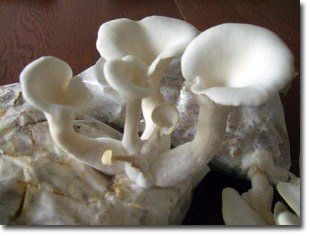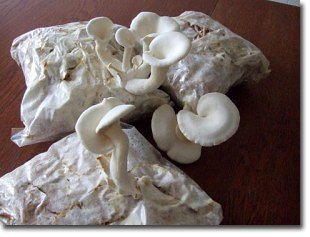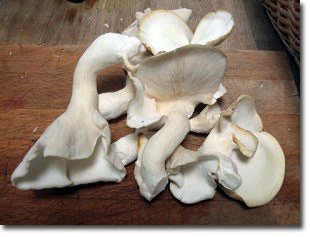HOW TO GROW YOUR OWN OYSTER MUSHROOMS ON STRAW Leave a comment
HOW TO GROW YOUR OWN OYSTER MUSHROOMS ON STRAW
by Dr Samuel Alexander, co-director of the Simplicity Institute and a lecturer with the Office for Environmental Programs, University of Melbourne.
 I’ve been experimenting recently with growing my own oyster mushrooms, and as you can see from the photos, I’ve met with some success. I was motivated to explore mushroom cultivation partly because I’m a vegetarian and want to produce my own high-protein alternatives to meat; but I was also interested in using so-called ‘dead space’ to grow food (either inside or down the shady side of the house). Oyster mushrooms tick both these boxes, and they are also ridiculously tasty. Seriously.
I’ve been experimenting recently with growing my own oyster mushrooms, and as you can see from the photos, I’ve met with some success. I was motivated to explore mushroom cultivation partly because I’m a vegetarian and want to produce my own high-protein alternatives to meat; but I was also interested in using so-called ‘dead space’ to grow food (either inside or down the shady side of the house). Oyster mushrooms tick both these boxes, and they are also ridiculously tasty. Seriously.
Not only that, oyster mushrooms are extremely expensive when purchased from a supermarket, so it makes sense to grow them yourself. Currently in Melbourne they are going for $34 per kilo.
I’m no mushroom-growing expert, so do your own research, but below I’ve outlined how I’ve successfully grown my own oyster mushrooms on straw. It’s surprisingly easy, although you do need to take appropriate precautions to make sure you are growing the right mushrooms and in a hygienically safe way. Apparently white oyster mushrooms are the easiest variety to grow, which is why I started with them.
And do it the old fashion way, like our fore-fathers did it and succeed long before us, because what lies ahead of us will require all the help we can get. Watch this video and learn the 3 skills that ensured our ancestors survival in hard times of famine and war.
What you need:
- Straw (I used pea-straw successfully but I’m told wheat straw is better)
- Robust plastic bags, medium or large size (which can be reused)
- Oyster mushroom spawn (which I got from CERES in Melbourne and are also availablehere). You may need to find your local supplier.
- Spray bottle and water
 My 10-Step Method:
My 10-Step Method:
- Before you begin, wash your hands and clean all your surfaces well. It’s very important to be hygienic when cultivating mushrooms, as you do not want to grow the wrong types of fungi! Good mushrooms are really good; bad mushrooms are really bad. Fortunately, oysters mushrooms are very distinctive.
- Once you’ve got all the materials, the first thing you need to do is pasteurise the straw. From my research online, I discovered that this essentially means heating the straw in water to around 70-75 degrees (Celsius) and holding it at that temperature for around 45-60 minutes. I used a large Fowlers cooking pot. Pasteurisation kills the bad bacteria but leaves the good bacteria. Before you put the straw in the pot, most websites recommend that the straw is cut up into small pieces, around 1 to 3 inches in length. (To be honest, I didn’t cut up my straw, and I still grew mushrooms, but perhaps if I had cut it up my production might have been greater — further experimenting required.)
- Once you’ve pasteurised the straw, take it out of the heating pot with tongs and let it sit in a clean tub while it cools down. Be careful as you’re dealing with a lot of hot water and the pot will be heavy. It’s important you don’t put the mushroom spawn into the straw until the straw is at room temperature otherwise you will kill the spawn.
- When the straw has cooled down, pack your robust plastic bags with straw quite tightly, and then distribute some of the mushroom spawn throughout the straw. I put about three or four pieces of spawn-covered dowel in each bag, but perhaps one would have been fine (further experimenting required). The straw should not be dripping wet, but it should still be damp from the pasteurisation.
- At this stage, sterilise a skewer or a nail (by pouring boiling water over it) and jab holes in the bags every 3 inches or so. This lets some air in, but not too much.
- You now have to find a home for you mushrooms. Keep them out of direct sunlight. They like some indirect light and I am told they like it best at around 15-20 degrees Celsius. (It’s been considerably warmer than that in Melbourne over the last two months, and mine have grown very well, but again perhaps the yields would have been greater had the temperature been cooler). More experimenting required. I kept my bags inside to minimise the risk of contamination.
- Now you wait while the mushroom spawn develops into mycelium and begins taking over the entire bag. Mycelium looks a bit like white furry cobwebs, and you should start seeing it develop in the first couple of weeks. It’s important that your bags of straw stay moist, but not dripping wet. I found that the water from the pasteurisation was sufficient to keep the straw suitably moist without needing to spray with water.
- After a number of weeks (depending on the size of your bags) the mycelium should have spread across the entire bag of straw. It is at this stage (which for me was about 5 weeks later) your mushrooms should start forming. I cut some slightly larger holes in the bag, although I’m not sure this was necessary. The mushrooms will decide that they want to grow out of one or more of the holes you’ve created, and they’ll usually grow in one or two clusters.
- Now comes the fun part. The mushrooms essentially double in size every day, so within a week or so you should have good-sized oyster mushrooms. Mist them with water two or three times a day over this period – again, not so they are dripping, just so they are moist. The mushrooms should be harvested while their rims are still curled over a little and pointing downwards. If their rims seem to be turning upward, it’s probably time to harvest.
- Harvest and eat. To harvest the mushrooms give them a twist at the base. This ensures that you leave the very bottom of the mushroom still in the bag. You want to leave that part behind as it is needed for the subsequent flushes of mushrooms. If you keep the mushrooms moist and in suitable conditions, you should get three or four flushes of mushrooms, although I’m told the first and
 second flushes are the most productive. I’m currently harvesting my second flush. When your bags stop producing, the straw can be used as mulch for the garden. (Alternatively, my understanding is that you can distribute some of your straw into new bags of fresh straw and the growing process begins again).
second flushes are the most productive. I’m currently harvesting my second flush. When your bags stop producing, the straw can be used as mulch for the garden. (Alternatively, my understanding is that you can distribute some of your straw into new bags of fresh straw and the growing process begins again).
If there are any mushroom experts out there, do let me know if you have any advice, and if any of you decide to begin cultivating your own mushrooms, do let me know how you get on. I’m going to keep experimenting in the hope of developing the easiest and most productive methods.(source)
How to Grow Massive Oyster Mushrooms in Your Straw Garden, Part 1
The elm oyster mushroom loves to grow on straw. This video is a short tutorial how to grow elm oyster mushrooms in your own garden. When the mycelium is mixed into the straw and used as mulch for your garden, multiple benefits occur….the straw is rapidly broken down to feed the plants, water is retained and, of course, edible, gourmet mushrooms are produced along side your vegetables.
RELATED : The Best Way to Grow Sweet Potato in Straw Bales, Bags and Containers
90 days after inoculation with a spent 100th Monkey Mushrooms Elm Oyster mushroom kit, this straw mulch bed has already produced 15 pounds of edible, gourmet, medicinal mushrooms!
Don’t wait until food becomes scarce; start preparing for the future now by becoming as self-reliant as possible. Your long-term chances of survival could very well depend on your ability to feed yourself and your family without relying on someone else.
Carnivore’s Bible (is a wellknown meat processor providing custom meat processing services locally andacross the state of Montana and more. Whether your needs are for domestic meator wild game meat processing)
The Lost Book of Remedies PDF ( contains a series of medicinal andherbal recipes to make home made remedies from medicinal plants and herbs.Chromic diseases and maladies can be overcome by taking the remediesoutlined in this book. The writer claims that his grandfather was taughtherbalism and healing whilst in active service during world war twoand that he has treated many soldiers with his home made cures. )
Easy Cellar(Info about building and managing your root cellar, plus printable plans. The book on building and using root cellars – The Complete Root Cellar Book.)
The Lost Ways (Learn the long forgotten secrets that helped our forefathers survive famines,wars,economic crisis and anything else life threw at them)
LOST WAYS 2 ( Wordof the day: Prepare! And do it the old fashion way, like our fore-fathers did it and succeed longbefore us,because what lies ahead of us will require all the help we can get. Watch this video and learn the 3 skills that ensured our ancestors survival in hard times offamine and war.)
Please Support Our Sponsors
Solar Power Generator Discounts Along With Free Shipping
- 10% OFF for Jackery Solar Generator 2000 Pro Series with code "JADEAL"
- 10% OFF for Jackery SolarSaga 200W Solar Panel with code "JADEAL"
- 10% OFF for Jackery Solar Generator 1500 Series with code "JADEAL"
- 10% OFF for Jackery Solar Generator 1000 Series with code "JADEAL"
- 10% OFF for Jackery Explorer 1500 Portable Power Station with code "JADEAL"
- 10% OFF for Jackery Explorer 1000 Pro Portable Power Station with code "JADEAL"
- 10% OFF for Jackery Explorer 500 Pro Portable Power Station with code "JADEAL"
- 10% OFF for Jackery Explorer 300 Pro Portable Power Station with code "JADEAL"
- 10% OFF for Jackery SolarSaga 100W Solar Panel with code "JADEAL"

The University of Georgia is represented by the Georgia Bulldogs . The Bulldogs participate in the Southeastern Conference's (SEC) Eastern Division of the NCAA.
They play their home games in the storied Sanford Stadium in Athens, Georgia. The first season in Georgia was in 1892. In 1942, 1980, and 2021, the Georgia Bulldogs won three national championships.
The Georgia Bulldogs have additionally been crowned the National Champion in four additional seasons by at least one polling organization (1920, 1927, 1946 and 1968).
The Georgia Bulldogs are tied for second place in conference history with their 15 conference titles, including 13 SEC titles, and their 59 bowl appearances, which ranks second all-time.
In addition, the program has produced five top picks in the National Football League (NFL) draft, two Heisman Trophy winners, numerous winners of various national honors, and many others.

Longhorns football represents the University of Texas in Austin often known as Texas, UT or the Texas Longhorns. The Longhorns represent the Big 12 Conference in the NCAA Division. They play in Austin, Texas, at the Darrell K. Royal-Texas Memorial Stadium.
The Texas Longhorns are ranked third and seventh, respectively, in terms of all-time wins and win-loss records, with over 900 victories and an overall win-loss percentage of.705.
The legendary program also boasts four national titles, 32 conference titles, 100 First Team All-Americans, and two Heisman Trophy winners.
Get your Texas Longhorns Revival T-Shirt today. The Texas Longhorns Rustic Revival shirt is also a fan favorite.
Many college sports fans like to wear their gear all around town, get your Texas Longhorns Centered gear and show your support.





 Gettr
Gettr














